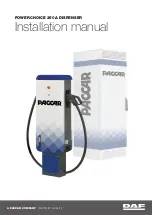
EXPORT POWERDRIVE CHARGER (ONBOARD)
Test Procedures
2008 Export Battery Charger Maintenance and Service Manual
Page 4-11
4
TEST PROCEDURES
See General Warning, Section 1, Page 1-1.
INDEX OF TEST PROCEDURES
1. Battery Voltage
2. Control Board
3. AC Power and Continuity Check of AC Circuit
4. Diodes
5. Charger DC Circuit Continuity Test
6. Transformer
7. Battery State of Charge Test
8. Continuity
TEST PROCEDURE 1 – BATTERY VOLTAGE
See General Warning, Section 1, Page 1-1.
Test Procedure 1A – DS Villager 4
1. Check the wire connections between the vehicle and battery charger
(Figure 4-2, Page 4-3)
.
1.1. Verify that the 10-gauge red wire of the charger is connected to the positive (+) post of battery no. 1.
1.2. Verify the connection of the 10-gauge black wire from the onboard computer and the 10-gauge
black wire from the battery charger at the fuse link on the charger receptacle.
1.3. Check the connections of the DC cord blue wire (17), from the charger, and the gray wire, from the
onboard computer, to the the 3-way wire adapter (18)
(Figure 4-29, Page 4-36)
.
See following
WARNING.
ý
WARNING
• Do not bypass the sense lead fuse.
1.4. Remove the gray sense lead fuse and check it for continuity with a multimeter set to 200 ohms. The
resistance should be less than 2 ohms.
2. With a multimeter set to 200 volts DC, measure the voltage of the battery pack between the positive (+)
post of battery no. 1 and the negative (–) post of battery no. 4
(Figure 4-6, Page 4-12)
. Normal no-load
voltage should be between 50 and 52 volts for fully charged batteries. The voltage of the battery pack
must be over 34 volts DC to allow the onboard computer to close the charger relay.
If battery pack voltage
is too low to start charger, temporarily bypass the charger relay.
See Charging a Battery Pack that has
Low Voltage on page 4-33.
















































